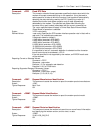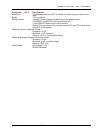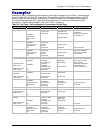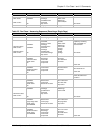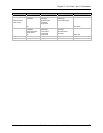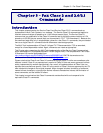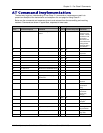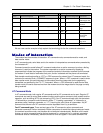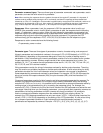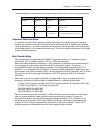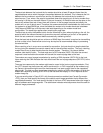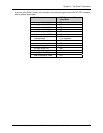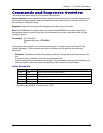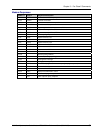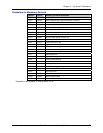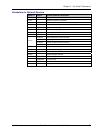
Chapter 3 – Fax Class 2 Commands
Multi-Tech Systems, Inc. SocketModem MT5634SMIxx Reference Guide (S000263C) 51
Parameter command types. There are three types of parameter commands: set a parameter, read a
parameter, and read the valid values for a parameter.
Note: When receiving fax responses from the modem, the state of the regular AT parameter V is important. If
verbose mode is enabled (set by issuing the ATV1 command), and then all responses will be preceded and
followed by a <CR><LF> combination. If terse mode is enabled (set by issuing the ATV0 command), and then all
responses will be followed by <CR> only. Also, regular AT responses are affected by the same V parameters
(e.g., verbose response: OK, terse response: 1). All examples in this chapter assume verbose mode.
Responses. When a parameter is set, the response is OK if the parameter value is valid, and
ERROR if the parameter value is invalid. When a parameter is read, the response has the following
format: +F<parameter_name>=<value>. When the valid values for a parameter are requested, the
response is given as a valid parameter string as described below. When action commands are given,
responses may be given to report the progress of the action command. For example, the ATD
command may give the responses +FCO, +FIS:0,2,2,2,0,0,0,0 before the OK response is given.
Responses to action commands have the following format:
+F<parameter_name>:<value>
.
Parameter types. There are three types of parameters: numeric, character string, and compound.
Numeric parameters are hexadecimal numbers in the range 0–FFh (0–255 decimal) or 0–FFFFh (0–
65535 decimal), depending on the parameter being set or read. Any number of leading zeros is
permissible. A valid values string for numeric parameters consists of a list of numbers and/or number
ranges separated by commas. Number ranges consist of two values separated by a hyphen. For
example, (A, 14-17, 1e) means the valid parameter values are Ah, 14h, 15h, 16h, 17h, and 1Eh (10,
20, 21, 22, 23, and 30 in decimal notation).
String parameters consist of a string of characters enclosed by double-quote characters. The string
may not contain non-printable characters or double-quote characters. A valid values string for string
parameters consists of a list of valid character values and character value ranges in hexadecimal
format separated by commas and enclosed in parentheses. For example, (20, 2b, 30-39) means the
string can consist of the space character (20h), the plus character (2Bh), and the characters 0–9
(30h–39h).
Compound parameters consist of a list of numeric and string parameters separated by commas. For
example, the compound parameter DIS consists of eight numeric parameters set by the following
command AT+FIS=n,n,n,n,n,n,n,n). It is possible to omit values from a compound parameter either by
omitting values in the parameter string or by truncating the parameter string. For example, the
command AT+FIS=,,2,0 sets only the third and fourth values of the DIS parameter and leaves the rest
unchanged. Note that when you omit leading parameters, you must leave their separation commas as
placeholders, but trailing parameters and their commas can simply be omitted. It is possible to
receive a compound parameter response from the modem that will have missing values. For
example, the +FPS response sometimes has only two values (+FPS:1,1134) and other times has five
values (+FPS:1,1134,30,4,0), depending on the setting of the +FCQ parameter). A valid values string
for a compound parameter consists of a valid values string for each parameter enclosed in
parentheses and separated by commas. Example: +FIS (0-1), (0-3), (0-4), (0-2), (0), (0), (0), (0-7).



